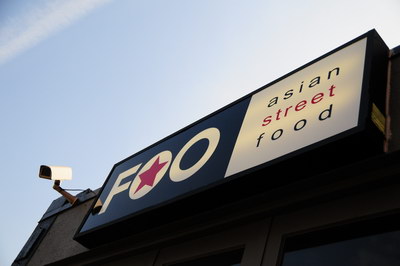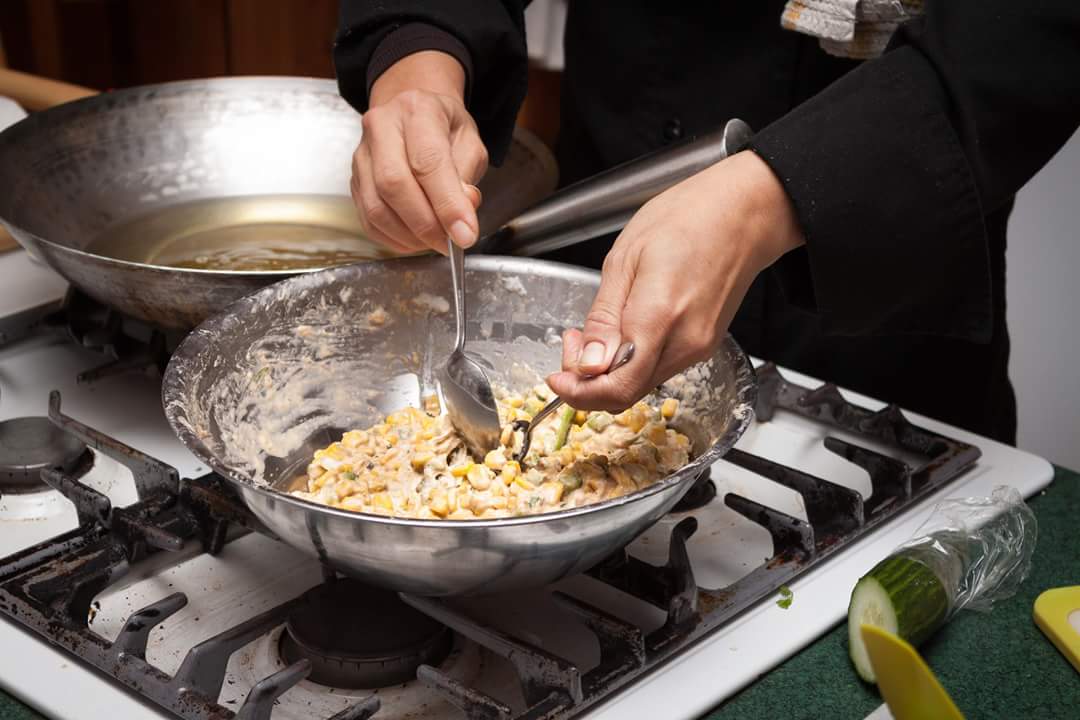End of September 2014, I was grateful to have the good fortune to do a short few months (relatively speaking) backpacking trip with friends and family which included China (Part 1, Part 2, Part 3, Part 4, Part 5, Part 6), Malaysia, Cambodia, Vietnam, Indonesia, Singapore and Korea. I’ll be writing an 12-part series of the trip on the food that was memorable enough to have made it onto my camera.
China – Part 3
Where? Beijing
A long messy train ride from Pingyao and 10 – 14 hours later lands me in Beijing. The short story is we messed up on booking tickets on Ctrip, an Expedia-esque travel webste in China. I switched some numbers around on the passport and that rendered a ticket invalid, and impossible to change or refund. What I bought were 4 soft sleeper tickets – one for each of the three of us, one extra one, and one hard sleeper ticket just in case we got screwed. We definitely got screwed. Because of my booking errors, they refused to honour one of the soft sleeper tickets. Even my best attempts at gaining pity by explaining our situation to the train officials was useless, because rules are rules.
I sucked it up, and because it was my mistake I went to the hard sleeper section which was an experience itself. Ever been on triple stacked bunkbeds with two rows per section? You can’t even sit up! And because it’s China, the general public doesn’t care about quietness or rules. I got to enjoy loud talking, and second hand smoke all night long. For the average North American like myself, the hard sleeper is is a bit of a zoo. But for average Joe in China, a hard sleeper is pretty good already! I shouldn’t complain because I could’ve been extra screwed if they ran out of hard sleepers and I got stuck sitting, or even standing. Damn, that would really suck. It was a good thing I forged my public transportation thick skin against the unruly public through my twice a day 38-Geary commute in San Francisco – the Scary Geary aka the Dirty Eight.

Courtesy of StudyInChina @ Universal Blogs
The final hour was a somewhat romantic experience as watched golden light pour into the cabin through Beijing’s yellow hazy skies. What was apparently a famous pop tune started playing on the speakers as we slowly chugged towards the capital of the Central States. The melancholic music added to the atmosphere.
Napoleon Bonaparte famously once said “China is a sleeping giant. Let her sleep, for when she wakes she will move the world.” Our boy Napoleon here certainly had some insight while doing his thing in France, or maybe he had a crystal ball that shows what happens when it comes to the leaving the Beijing Railway Station.
We unceremoniously disembarked the train, attempted to get out of the station and were immediately swallowed by the crowd that was an OCEAN OF PEOPLE. It was an unbelievable congestion of humanity. We’re talking “grab on to my hands, hold on for dear life and I’ll lead you out of the club so we don’t get separated on a sloppy Saturday night” levels of closeness. I know crowds as I’ve lived in Japan before, but there’s something about those stark and uninspiring interiors at 7am in the morning that is especially jarring. When China isn’t sleeping, it’s most definitely crazy as shit. And this is just the train station on an uneventful day, I cannot imagine what it is like on national holidays. But I do suppose that all roads lead to Beijing, so I should’ve expected that. I was legitimately concerned about being separated from my sisters since I probably would never find them again. While in Asia, it seems I lost my usual tactic of “look for the Asian people” I employ back home.
Ok, enough about trains. Let’s fast track this. We navigated the armpit-to-armpit no personal space of a subway system, found our old school courtyard style hostel (which was very cool btw) in one of Bejing’s disappearing Hutong’s – old school charming alleyways found in Old Beijing. We set out to find some food, not realizing I was going to taste some of the most memorable things of my life.
Locals seem to talk about ‘Lao Beijing’ – Old Beijing’s specialties and ‘xiao chi’ – small eats or snacks. I love snacks, and we found this small shop around the corner akin to a coffee shop/cafe/bakery that sold this kind of stuff. Perfect. Curiously, everything here is Halal too! It turns out that Beijing in the Qing era had a large number of Chinese muslims which shaped the culinary traditions in the city.
A clear winner that we found here were Shao Bing, a baked unleavened flakey flatbread with meat sandwiched inside. I had variants of this in Taiwan before so it was familiar territory.
We ordered this Gao Dian sample platter, which I suppose translates to small bites of cake/biscuit/pastry. We wanted to try new things and being in the the old imperial capital where emperors ate anything they wanted, I reasoned that Beijing food had to be good. I was excited to try what Old Beijing had to offer. Little that I know that I was playing Russian Roulette with food without realizing it.
Let’s go counter-clockwise from the top-left down and see what we have (more like what I remember).
- Black Drink – I don’t remember. But I’m 100% sure it was a type of ‘cooling drink’.
- Yellow block that looks like cheddar cheese. Cheese it is not, “Wan Dou Huang” it is. It is a pea flower cake, I originally thought it was a mungbean cake. Slightly crumbly in texture, subtle flavours and rather delicate.
- Brown thing with brown flour. This is apparently called Rolling Donkey, or “La Da Gun”. Sticky rice, with red bean paste inside and rolled with soy flour. I remember not liking the soy flour, but otherwise it was pretty decent.
- The three timbit donut hole looking things at the bottom. I don’t quite remember. If anything, I expected to be sweet but don’t remember it being so.
- Yellow crumbly thing on the side of the plate. This is Sa Chi Ma. It has its origins as a Manchu (the tribe that ruled the last dynasty of China, Qing Dynasty) dessert. It’s fluffy deep fried dough strings held together with sugar. I remember this not being sweet. The ones I usually have are noticeably a lot sweeter. It’s easily found in T&T in Canada and Ranch 99’s in USA.
- Fried Fritters – dough deep fried. Very sweet.
- Purple cabbage was pickled. It was ok. I’m not a big fan of sour or pickled things in general.
- This was definitely a Hawthorn cake. I still don’t really know what Hawthorn is aside from those haw flake sweets I used to eat all the time as a kid. I really like the taste of Hawthorn and enjoyed it in cake like form.
- White cabbage pickled.
- This. This. This on the top right. The innocent looking bowl of slightly green stuff. It is called “Dou Zhi”, which the locals charmingly add the RRR to it so its more like “Dou zhi-rrrrrrrrrr”. I’m too immature and I digress. This translates to Bean Juice which in my mind seemed like a derivative of soy milk, “dou jiang”. I take a sip of it and sweet baby jesus, I wish I had a local warn me what it would taste like. It was some SERIOUS fermented stuff with a rank taste to it. It is a very sour and sharp taste. Your frame of reference should be your first experience eating a very ripe and sharp blue cheese as a feeling. I really hate saying things taste gross because I grew up with people always telling me what I ate was gross all the time. So as a result, I don’t like being “ew” about unfamiliar things on the first try. I just don’t have the appreciation for it. I firmly believe in giving food 2-3 chances before I make up my mind. But fellow foodies, please forgive me as I commit this cardinal foodie sin of a description. I truly believe it tastes like sewer water. It was vile. In fact, my sisters felt the same and offered me 100 RMB (around 15 USD) to down it as a dare. For reference, this meal only cost 30 RMB in total. I told the siblings that I still wouldn’t drink it even if they tripled it. I look beside me and see this old man drinking it with much enjoyment and I was envious. Douzhi is made from mung beans, and fermented and a byproduct of cellophane noodle production. I later talked to our driver about our experience and even he was surprised we tried it since he doesn’t drink it himself and he’s definitely born and raised in Beijing. For those searching for authenticity, this is it. It’s extremely old school and a very acquired taste.
- The brown soup like thing was a bit of a surprise to the Southern Chinese aka Cantonese to me. This looks like sweet soup which I was hopeful for since I like it. At first glance I would say it looks like a peanut or almond thick sweet soup to me which I really like. Nope, Beijing got its laugh at me again. It’s Mian Cha which translates to Flour Tea and has nothing to do with tea. It’s a porridge made from millet and rice flour mixed together with water to produce the white looking stuff. Then a sesame paste with some salt, sugar and stuff is poured on top which is the brown goo. It was very thick, very chalky tasting with a chalky texture and was definitely not sweet. I remember not really caring for it either, but it wasn’t extremely polarizing.
It is my understanding that these were all enjoyed in the Forbidden City by the imperial family. What I had there was probably the most foreign Chinese food I’ve ever sampled. I mean, it was somewhat familiar by looks but incredibly different in tastes. I kept expecting things to taste and feel a certain way only to be punked every time. Those Northern Chinese sure have different tastes.
You can vicariously live the experience of visiting one of these old Beijing Cafes through this video. Start it at 6:00.
I broke down and had my first McDonald’s here in Beijing. It was about 2 weeks in and I was dying to have something that’s not Chinese. McChicken and fries never disappoint. In fact I do make it a point to visit global chains in different countries as I find the localization of the product fascinating. For instance, Coke here really isn’t that sweet and I kind of like it like that instead of the cavity inducing sweetness in America. And who can say no to Pineapple or Taro Pies? As a plus, they’re still deep fried! I don’t know why in USA or Canada we get these lame baked apple pies. Nobody wants those.
I also found Yoshinoya, the famous Japanese chain for Gyu-don. Beef rice. I really quite like it as a fast food item. Big portions, cheap prices and tasty. I had an Icelandic friend when I was living in Japan that LOVED it. I mean, this guy was obsessed with it. I was happy to chow down on some nostalgia in China.
No trip in Beijing will be complete with Peking Duck. Peking is the old school romanization for Beijing and means the same place. In Chinese, the true authentic stuff is Bei Jing Tian Ya, Beijing Stuffed Ducks. They use a certain breed of ducks and they’re force fed to fatten them up to roast. The history of the duck dates back to the 1300’s and there’s a lot of famous places in Beijing to try out. Quan Ju De is apparently THE place to go to for the quintessential experience. But we didn’t make it out there and trusted our Lonely Planet guide once more which fortunately didn’t lead us astray this time to Li Qun.
Li Qun is this (not so much anymore) hole in the wall Beijing Duck restaurant in a hutong. It’s atmospheric and very casual. It’s also VERY famous. I’ve never seen so many photos of handshakes with movie stars, ambassadors, presidents, prime ministers plastered on the walls of the few halls the restaurant has. A relative of ours later said “How did you guys find it? This is the usual place I bring people to try out in Beijing”.
We tabled shared with a group 3 friends which was very interesting. I like this communal table sharing actually and wish there would be more of it in America. They seemed like they knew the place quite well, and ordered ahead of us while we did our own thing. Upon hearing us speak, they were intrigued to see where we’re from which responded Canada and had some colourful conversations which included America Hating as the Chinese Chinese feel like they get bullied by USA, and about perceptions of Canada. The consensus is that Canada is generally positive and non-corrupt, but it is also the place where all the corrupt Chinese officials bail to.
Our new friends insisted we try their food and we politely declined at first, but graciously accepted later.
These guys definitely know what they were ordering as they insisted we try their food. Two instant favourites among the three of us were a cold plate of duck liver which was very fois gras-like and the deep fried salt and pepper duck intestines which I found to have a very satisfying crunch. I enjoyed both a lot
The duck came with it usual assortment of scallions, cucumbers, hoisin sauce.
To be very honest, Beijing duck to me is still a bit of an enigma on how it’s ‘supposed’ to be prepared. It’s other variation is “Pian Pi Ya”, Sliced Skin Duck. Air blown through the body of the duck before roasting so the skin is separated from the body therefore making a very crispy layer. The crispy skin is sliced off so you can enjoy it individually, and then the meat is served later or maybe made into a stir fry or soup. That’s how we were served while eating it at home and very similar to what I get in Hong Kong.
The duck here was good. But was it very good? My inner critic says it reaches par. I was rather surprised it came sliced like this in the pciture. It was a regular deboned roasted duck essentially. But again hey, what do I really know? It’s my first time in Beijing.

Some great appetizers, doing what they’re supposed to do. Light snacks to prime you for your meal while you’re waiting. We were told this is “very” Beijing with the nuts and cold cucumbers.
All in all, Li Qun was a great experience in the sense of atmosphere. It’s definitely a no frills kind of place. Check out the toilets, these were the closest pictures I could find. But I swear that it was actually four toilets arranged in a square facing each other. Either way, I found this hilarious, who needs privacy anyway?
But back to the dining of Li Qun, Some people say its quality has declined and gotten too expensive because of its fame. If I lived in Beijing, I’d definitely take people there for the experience. While we were very full, we left rather unsatisfied of the Beijing Duck experience. So in true fashion, we decided to seek out another restaurant that served it. One can never have enough duck.
We were in Bejing for couple more days so I looked up “Time Out Beijing” and found Shi Ji Min Fu, which I can’t seem to translate. But it’s a very trendy and more upscale place and that serves the best Bejing Duck for it’s value. The ambiance was ‘classy’ and ‘upscale’.
The duck is still presented in a similar fashion. But this time the skin is served to you Pian Pi style, sliced off. What is truly unique about it is that the skin was very very crispy. I suspect it after the duck is roasted it is ladled with hot oil to give it a quick fry effect on the skin. The feel of the skin it is similar to eating a well rendered piece of bacon fat. It’s fatty, but not greasy with that airy crunch to it. Here, you dip the skin in some sugar and eat it which is something I’ve never done before. I quite like it.
The three of us really enjoyed our experience at this place. It served top notch food and definitely knew what it was doing. We ordered some sweets again, which were not sweet and and we felt ambivalent towards it as well. The Imperial Chinese ‘sweets’ just isn’t for us.
Thinking back to what Time Out Beijing said about the duck and value of it for what you pay, I completely agree. It was the best roasted duck I’ve had.
























1 Response
[…] speaking) backpacking trip with friends and family which included China (Part 1, Part 2, Part 3, Part 4, Part 5, Part 6), Malaysia, Cambodia, Vietnam, Indonesia, Singapore and Korea. I’ll […]